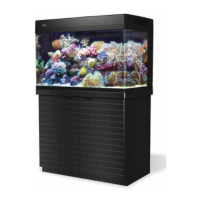35
USER MANUAL
Remember to consider the desired species' maximum sizes when
calculating this figure.
Invertebrates
Among the many species of invertebrates available to the hobbyist,
you will find differences in the natural habitats of these creatures
that dictate the physical conditions required for them to flourish,
such as light and current. Corals adapt well to different lighting
conditions, but some are more sensitive to change than others.
Corals take time to adjust to new environments, though you can
help this process along.
If your corals come from a mature reef aquarium:
Try to place them such that their new environment duplicates
the original lighting and currents as closely as possible. You
will know that the coral has adjusted when it expands fully
and displays vibrant coloration.
Continue to monitor the coral's adjustment to its new location.
If it appears to shrink and decrease its coloration, relocate it to
another position.
Acclimation
The water that holds the fish and invertebrates during transport
has a different pH, temperature and salinity from that in your
aquarium. Fish, and especially invertebrates, react easily to even
minor changes in these parameters, so proper acclimation is the
key to their successful relocation.
To acclimatize your Livestock
Place the fish/coral/invertebrate, with all of the water from its
bag, into a bucket. Place the bucket on the floor next to the
MAX. With some air line tubing and a flow valve, run a siphon
drip line from the MAX to the bucket. Start a siphon and slowly
allow the tank water to drip into the bucket, using the valve to
adjust the drip rate. Keep the drip fairly slow; too fast a drip can
change the parameters too quickly and shock the creatures.
When the volume of water in the bucket has doubled, test the
pH, salinity and temperature of the water. If they match the
tank's parameters, you can transfer all the livestock to the
aquarium. If not, continue with the drip method until the
parameters match. Be sure to remove water from the bucket to
prevent overflow, if necessary.
The stocked aquarium
The above steps should simplify and demystify the setup and
stocking processes for a reef aquarium. Remember to research
the needs of the fish and invertebrates you want to stock to
guarantee from the start that you have the time, energy and
resources to invest in their care. Try to resist the temptation to
add all the inhabitants at once. By stocking your aquarium slowly,
you greatly increase the creatures chances of survival and your
chances of long-term success. With proper setup, diligent patience
and care, your Red Sea MAX and its inhabitants will thrive.

